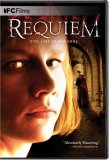A young woman leaves her small town and intensely religious family to study at University. Even as she experiences the new freedom of campus life, her epileptic seizures become much worse, and she gradually comes to the conclusion that she is possessed. Her friends try to help her as her suffering becomes intolerable, but she eventually turns to a priest who wants to perform an exorcism.
If the above synopsis sounds familiar, that’s because this film is based on the same case that inspired The Exorcism of Emily Rose. Requiem makes that other effort look utterly ridiculous. The case misleadingly promotes the film as a gothic horror flick, which it is not, though its story is undeniably horrific. There are no special effects, and the presentation of the symptoms comes down to Sandra Hüller’s remarkable performance as the unfortunate Michaela. By the time her symptoms are at their peak, we don’t need any CGI or tricked-up sound design to recoil in horror and pity from the tortured woman. Director Hans-Christian Schmid and writer Bernd Lange shy away from a supernatural explanation (while maintaining a certain degree of ambiguity), but this in no way lessens the horror of the proceedings. In fact, the cause of Michaela’s suffering is almost beside the point – the reality of that suffering is the true focus of the film. Though it must be said that the possibility lurks that religious belief is a contributing factor to the unfolding tragedy. Despite all the movies dealing with demonic possession, The Exorcist has really been the only one definitive exorcism film. Now, at last, there is a second, and Requiem succeeds so harrowingly because of its restraint, its utterly believable portrayal of characters and events, and its refusal to imitate William Friedkin’s film. It charts is own path, and does so with enormous assurance.
Audio
The film is tasteful but extremely powerful, and the same is true of the soundtrack. Environmental effects are constantly present, though never overwhelming. When the scene shifts to a nightclub, however, and we see Michaela losing herself in the music, the score becomes enormous, drowning us as it drowns her. Left-right separation is also excellent.
Video
There is some noticeable grain and edge enhancement here, and the colours are sometimes a bit pale. But given the gritty, almost documentary feel of the film and its 70s setting, the look of the transfer actually adds to the authenticity of the experience.
Special Features
Sadly, nothing but some trailers. This is, though, a film that can speak for itself.
Closing Thoughts
A definitive work. I can’t imagine we’ll be seeing a better exorcism film for a long time to come.
Special Features List
- Trailers






